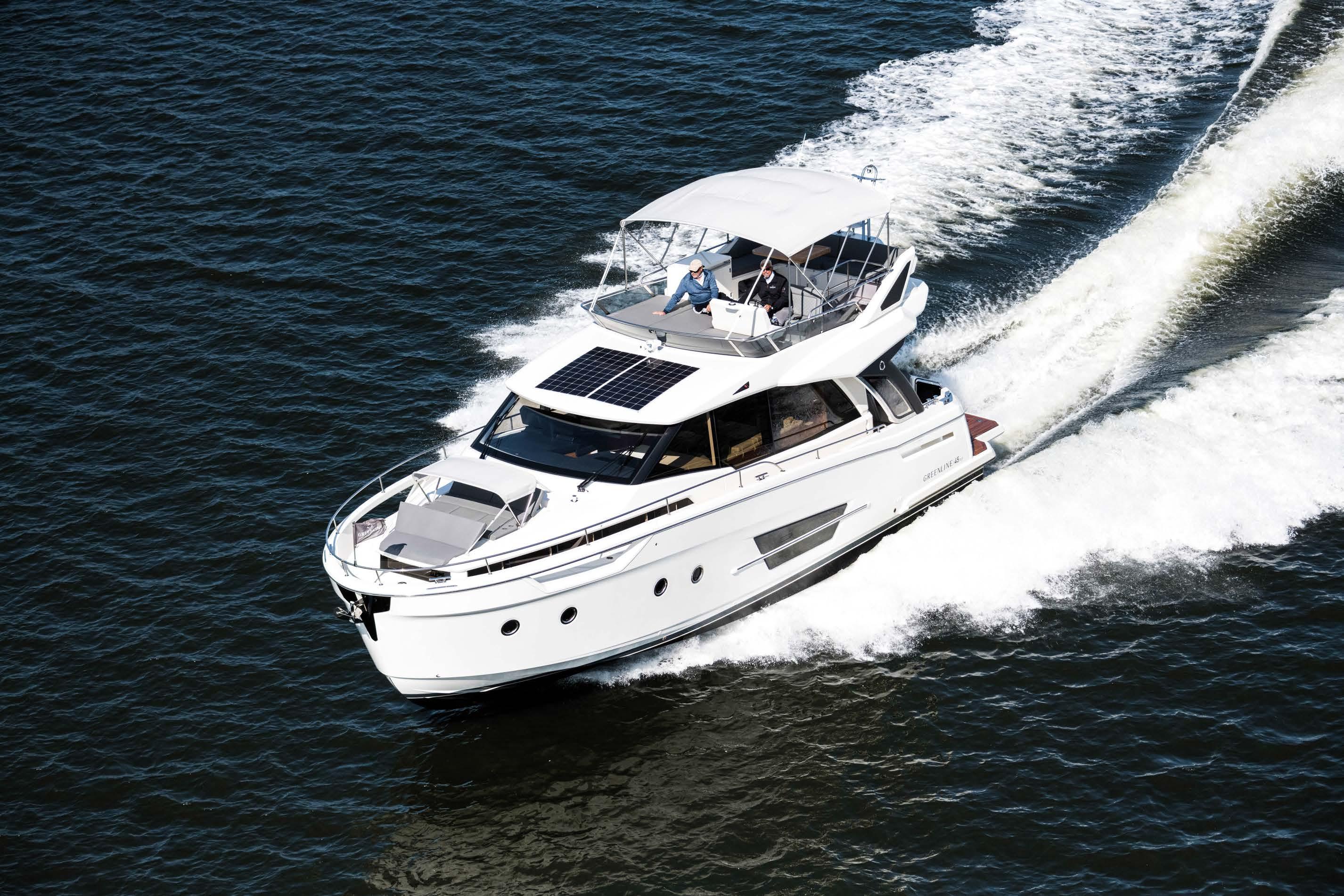
13 minute read
Greenline 45 Fly
Hybrid or not hybrid
PROPULSIONE ED ENERGIA DI BORDO OFFRONO TANTE OPZIONI. PER FARE TUTTO QUELLO CHE SI È SEMPRE FATTO CON UNA BARCA E ANCHE DI PIÙ PROPULSION AND ON-BOARD ENERGY PROVIDE MANY OPTIONS TO DO WHAT PEOPLE HAVE ALWAYS DONE ON BOATS AND MORE BESIDES by Niccolò Volpati photo by Jay Fleming
15.57m

Tutto non si può avere, ma almeno ci si può avvicinare molto. L’ibrido risponde alla filosofia di cercare di contenere il più possibile l’utilizzo del motore diesel perché è difficile farne a meno del tutto. La navigazione è sinonimo di libertà, di tante miglia percorse e in elettrico questo non è ancora possibile. L’autonomia è certamente più elevata grazie alle nuove tecnologie, ma non consente ancora di eliminare del tutto il motore endotermico, almeno che non si intenda utilizzare la barca a corto raggio. L’ibrido è quindi la soluzione che non consente alibi. Non è ancora la soluzione perfetta, ma è certamente la migliore di quelle possibili. Greenline è un cantiere sloveno che ha sposato questo concetto sin dal lontano 2008. L’esperienza nella propulsione ibrida non manca, con il tempo si è evoluta e oggi è in grado di offrire imbarcazioni sempre più performanti, contenendo il più possibile le emissioni. Gli elementi che compongono il sistema sono essenzialmente cinque: un propulsore diesel, la trasmissione, un motore elettrico con generatore, il pacco batterie al litio e i pannelli solari. Chi lo desidera può allestire i modelli Greenline in full electric, ma l’ibrido è, ad oggi, il sistema che consente di non fare rinunce. Partiamo dalla componente tradizionale. In sala macchine i motori sono due Yanmar da 370 cavalli con trasmissione in linea d’asse. Rappresentano una versione optional perché quella standard è una coppia di Yanmar da 250 cavalli. Con i 370 cv sono arrivato a una velocità massima di 24,3 nodi e planavo a 12. Più di 12 nodi di range di crociera, passando da 2340 giri/ minuto della planata minima a 3850 giri/ minuto della velocità massima. Buone prestazioni, in linea con tanti cruiser che si trovano sul mercato. Quello che distingue il 45 Fly sono i consumi perché sono davvero contenuti. Per planare bastano 50 litri/ora complessivi e alla massima si arriva a 146. Per navigare a 20 nodi di velocità bastano circa 100 litri/ora. Il merito è certamente anche del progetto, non solo dei propulsori. Lo studio J&J ha disegnato la carena e le linee d’acqua e la costruzione nel complesso appare solida e robusta, ma senza pesi eccessivi. La scia è una conferma di questa sensazione dato che è pulita e solleva poca acqua. Ciò che mi ha convinto meno è la timoneria perché non è molto morbida, al punto che virare è piuttosto faticoso. E poi c’è l’ibrido che consente di navigare in elettrico.
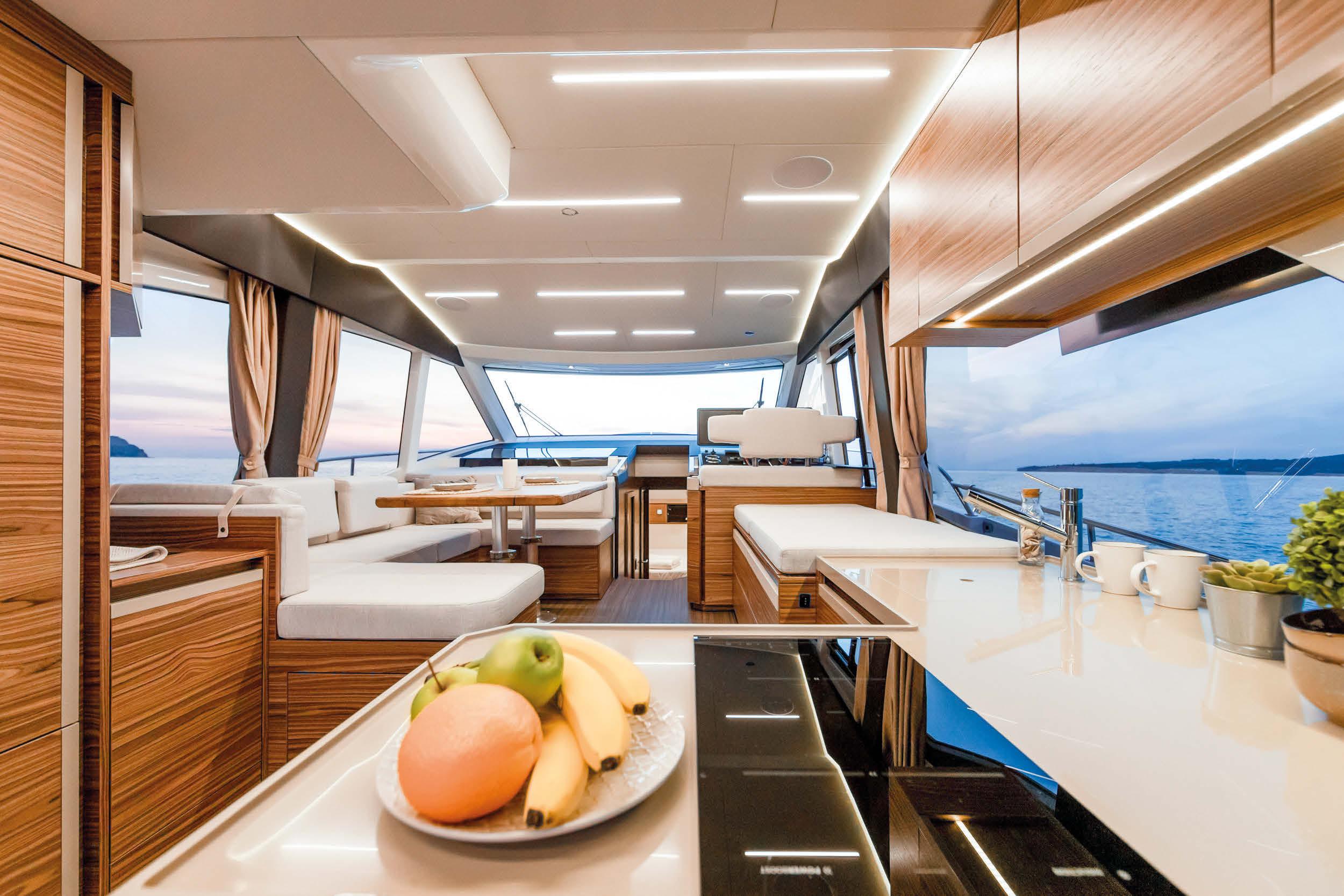
Gli spazi sono sfruttati razionalmente ed è facile muoversi a bordo.
The areas have been used rationally and it is easy to get around.


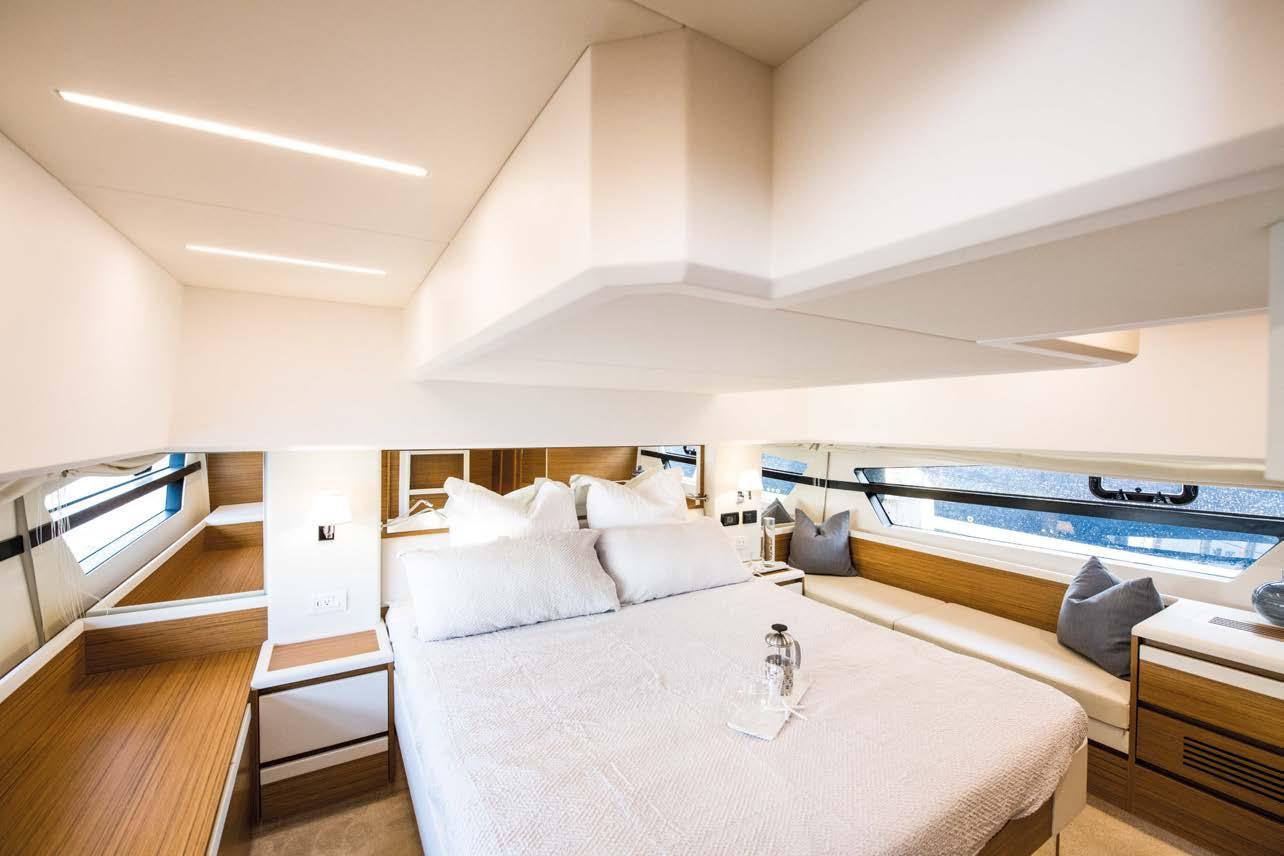
Si avvale di una potenza complessiva del motore elettrico di 28 kW che permette di navigare per 25 miglia a 5 nodi di velocità. La massima è di 6,5 nodi, ma, ovviamente, l’autonomia scende. Ma Greenline 45 Fly non è solo questo. La parte superiore dell’hard top è ricoperta di pannelli solari e il pacco batterie è costituito da modelli di ultima generazione al litio. La dimensione standard dei pannelli offre 0,6 kW, ma la versione optional permette di raddoppiare i pannelli arrivando appunto a ricoprire tutto l’hard top. In questo secondo caso la potenza erogata è di 1,2 kW. La presenza di un inverter e caricabatterie consente di utilizzare tutte le utenze di bordo quando si è ormeggiati in rada, senza avere la necessità di accendere il generatore. In conclusione, questo sistema permette di non fare rinunce. Se si vuole navigare con il motore diesel si hanno comunque bassi consumi e, grazie ai 1.500 litri di capienza dei serbatoi del carburante, l’autonomia sfiora le 300 miglia a regime di crociera. Quando si è sotto costa o in aree marine protette, si può utilizzare la modalità elettrica riuscendo a percorrere 25 miglia a cinque nodi di velocità. Infine, i pannelli solari e l’efficienza delle batterie al litio permettono di usare gli impianti di bordo, senza i generatori rumorosi e fastidiosi, per l’intera giornata. I layout di coperta e interni sono all’insegna dell’equilibrio. Non eccessivo, ma nemmeno limitato. I passavanti sono sufficientemente larghi, ci si muove bene e ci si sente protetti. La piattaforma di poppa ha una dimensione corretta. Assolve alla sua funzione senza essere ingombrante.

Tanta luce naturale e due cabine molto spaziose. Peccato che il piano di calpestio abbia un po’ troppi dislivelli.
There is a lot of natural light and two very spacious cabins. It is just a shame that the flooring has a few too many changes in level.


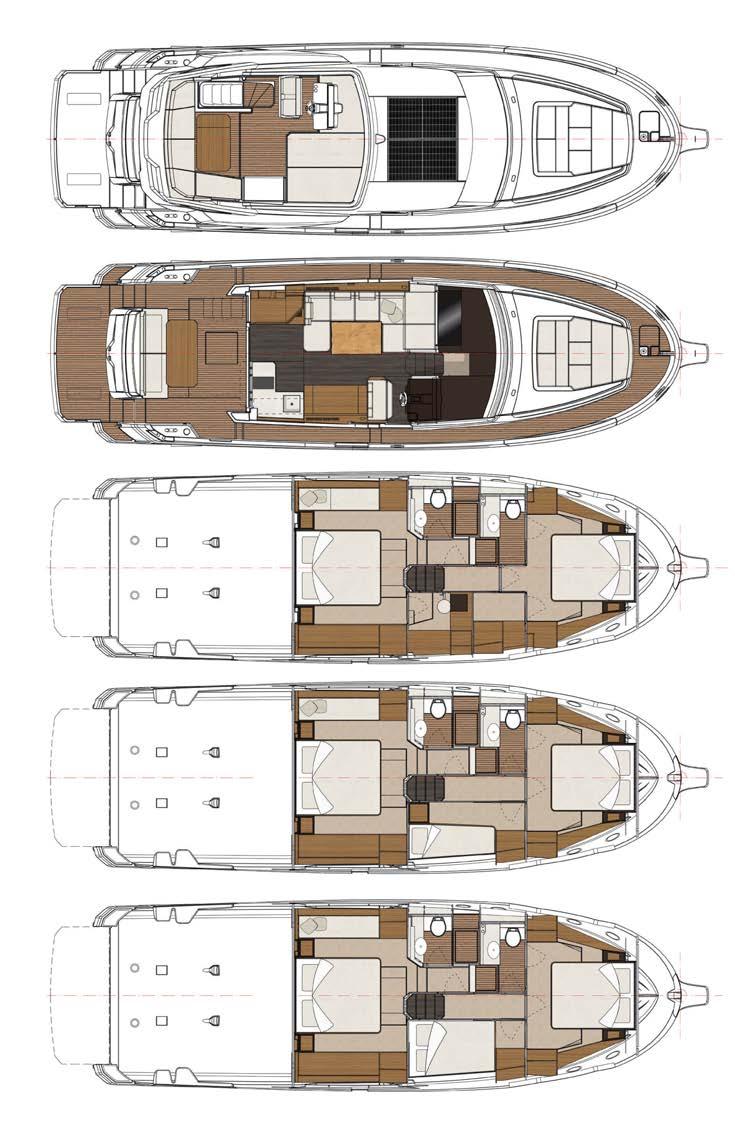

La prua è dedicata all’area prendisole e il pozzetto al living. La parte abitabile del fly è arretrata verso poppa perché la zona di prua, sopra la dinette, è occupata dai due grandi pannelli solari standard. In questa versione non c’è hard top e la protezione dal sole la si ottiene grazie a un tendalino di tipo tradizionale. Chi intende accentuare la capacità dei pannelli solari può invece optare per l’hard top ricoperto per intero dai pannelli. L’altro aspetto positivo è che la presenza del fly non appesantisce le linee. Merito anche di un profilo del parabrezza minimale che ripara chi è sdraiato sul prendisole, ma meno chi è al timone. Sottocoperta si apprezza la tanta luce naturale che filtra dall’esterno. Le cabine sono due, l’armatoriale a centro barca e la Vip a prua. Entrambe sono luminose, anche grazie a una seconda fila di finestrature più in alto, ed entrambe dispongono di bagno con box doccia separato. Quello che mi ha convinto meno è il piano di calpestio, sia della dinette, sia dell’area notte. Ci sono troppi dislivelli che non rendono semplice muoversi in questi spazi.
You can’t have it all, but at least you can get close. A hybrid engine satisfies an approach that seeks to keep the use of a diesel motor to as little as possible, given that it is difficult to do without one entirely. Using a boat is synonymous with freedom, of covering a lot of distance and it is not yet possible to do that using electric power. The range from electricity has certainly improved with new technology, but that does not yet mean that endothermic engines can be eliminated unless you only intend to use a boat for short trips. Hybrid is thus a solution that leaves no room for excuses. It is not yet a perfect solution, but it is the best of those available. Greenline is a Slovenian yard, which has adopted this concept way back in 2008.
IN SALA MACCHINE LE COMPONENTI DEL SISTEMA IBRIDO SONO MOLTE, MA TUTTE FACILMENTE RAGGIUNGIBILI. THERE ARE MANY COMPONENTS OF THE HYBRID SYSTEM IN THE ENGINE ROOM, BUT THEY ARE ALL EASILY ACCESSIBLE.
VELOCITÀ MAX NODI TOP SPEED KNOTS
24.3
AUTONOMIA MN RANGE NM
333
RAPPORTO PESO POTENZA MASS OUTLET POWER
kg kw
24.8
RAPPORTO LUNG./LARG. L/W
3.4
GREENLINE YACHTS Zapuze, 10a SI-4275 Begunje, Slovenia T. +386 4 5727734 www.greenlinehybrid.com Dealer M3 Servizi Nautici Via A. Divizia, 1/F, I-17051 Andora (SV) T. +39 0182 80180 www.m3nautica.com
PROGETTO J&J Design (naval architect and exterior design) • Marco Casali Design (interior design)
SCAFO Lunghezza f.t. 15,57m • Larghezza 4,57m • Pescaggio a pieno carico 1,10m • Dislocamento a pieno carico 13.500 kg • Serbatoi carburante 1.500 l • Acqua 600 l
MOTORE 2x8LV370 Yanmar • Potenza 272 kW (370 cv) • 8 cilindri • Cilindrata 4,46 l • Alesaggio per corsa 86mm x 96mm • Peso a secco 435 kg
CERTIFICAZIONE CE CAT B
PREZZO A partire da 577.000 €, Iva esclusa
PROJECT J&J Design (naval architect and exterior design) • Marco Casali Design (interior design)
HULL LOA 15.57m • Beam 4.57m • Draft at full load 1.10m • Full load displacement 13,500 kg • Fuel tank volume 1,500 l • Water tank volume 600 l
MAIN PROPULSION 2x8LV370 Yanmar • Outlet mechanical power 272 kW (370 hp) • 8 cylinders • Swept volume 4.46 l • Bore&Stroke 86mm x 96mm • Dry weight 435 kg
EC CERTIFICATION CAT B
PRICE
Starting from 577,000 €, excluding VAT CONDIZIONI DELLA PROVA CONDITIONS ON TEST
Località//Place Portorose (Slovenia) Mare//Sea state Calmo//calm Vento//Wind speed 0 Persone a bordo//People on board 3 Carburante imbarcato 350 l Fuel volume on board Acqua imbarcata 560 l Water volume on board
VELOCITÀ IN NODI SPEED IN KNOTS
CONSUMI L/H FUEL CONSUMPTION L/H
kn
24.3
22.4 122.6 146.2
20.8 110.8
18.6
15.8
13.9
12 50.8 72.8
62.2 84.4
11.3 46.6
0 20 40 60 80 100 120 140
Da 0 a planata in 10 secondi Gliding time of 10s from 0 to glide Da 0 a velocità massima in 31 secondi Gliding time of 31s for a speed change from 0 to 24.3 knots (maximum speed)
LITRO MIGLIO (VELOCITÀ DI CROCIERA) L/ NA MI (CRUISING SPEED)
4.5
Giri/min Velocità kn Consumi totali l/h Consumi litro miglio Autonomia mn Rumore su scala A (in plancia) dB Engine rotational Boat Total Fuel consumption Total Fuel consumption Range Sound level on scale A speed 1/min speed in knots (as volume flow) l/h (as volume hanging) l/ na mi na mi (at the dashboard) dB
2250 11.3 46.6 4,1 365 59 2340 12.0 50.8 4,2 357 59 2500 13.9 62.2 4,5 333 60 2750 15.8 72.8 4,6 326 62 3000 18.6 84.4 4,5 333 63 3250 20.8 110.8 5,3 283 66 3500 22.4 122.6 5,5 272 67 3850 24.3 146.2 6,0 250 68
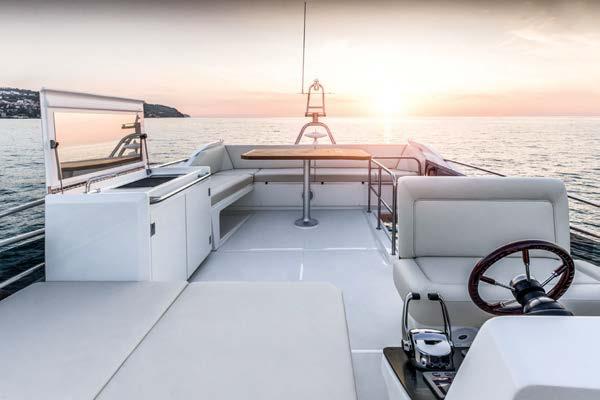
I PANNELLI SOLARI E LE BATTERIE AL LITIO DI ULTIMA GENERAZIONE CONSENTONO DI USARE TUTTE LE UTENZE ELETTRICHE MENTRE SI È ALLA FONDA SENZA LA NECESSITÀ DI ACCENDERE IL GENERATORE. THE SOLAR PANELS AND THE VERY LATEST LITHIUM BATTERIES MEAN YOU CAN USE ALL OF THE ELECTRICAL APPLIANCES WHILE YOU ARE AT ANCHOR WITHOUT NEEDING TO TURN THE GENERATORS ON.
There is no lack of hybrid propulsion, and over time it has evolved and can now provide boats with better and better performance while keeping emissions as low as possible. Five elements make up the system: a diesel engine, the transmission, an electric motor with a generator, a lithium battery pack and solar panels. Anyone who wants to can have their Greenline set up as full electric, but hybrid is currently the system which means you do not find yourself putting up with constraints. Let’s start with the traditional part of the system. The engine room has two 370 horsepower Yanmars with the in-lineshaft transmission. They are optional, as the standard fitting has a pair of Yanmar 250s. With the two 370s, I did a top speed of 24.3 knots and got to the plane at 12. So that gives a 12-knot spread of cruising speeds to choose from, going from 2340 rpm at planing minimum to 3850 rpm at top speed. Those are good performance figures, which are in line with a lot of cruisers that you can find on the market. What makes the 45 Fly stand out is that it does not use much fuel. To start planning you need just 50 litres per hour in total, and at top speed that gets to 146 litres. To do 20 knots, around 100 litres per hour is enough.


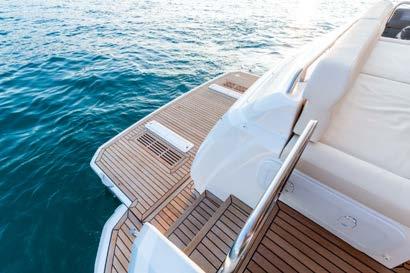
Engine room
I consumi con i due Yanmar di 370 cavalli ciascuno sono molto contenuti. A 20 nodi bastano circa 100 litri/ora complessivi.
The two 370-horsepower Yanmars do not use much fuel. 100 litres an hour in total is enough to do 20 knots.
That is thanks to the design and not just the engines. The J&J studio designed the hull and the waterlines and the overall construction seems solid and tough, but without being excessively heavy. Confirmation of that feeling comes from the bow wave, which is clean and does not bring up much water. What convinced me less was the helm, because it is very soft, to the extent that turning is an effort. And then there is the hybrid mode, which means you can be electrically powered. It uses the total power from a 28 kW electric motor which means you can go 25 nautical miles at five knots. The top speed is 6.5 knots, but of course, that does restrict your range. But the Greenline 45 Fly is more than just that. The upper section of the hard top is covered with solar panels and the battery pack has the latest lithium types. The standard size of the panels generates 0.6 kilowatts, but the optional version allows you to double the number of panels which means covering the entire hard top. That way, 1.2 kW is produced. Having an inverter and battery charger means you can use all of the onboard utilities when you are at anchor, without having to turn on the generator. So essentially this system means you do not have to do without anything. If you want to use the diesel engine to travel, you nevertheless get good mileage, and with the 1,500 litre fuel tank the range touches 300 nautical miles at cruising speed. When you are close to the coast, or in protected marine areas, you can use the electric mode and cover 25 nautical miles at five knots. And finally, the solar panels and efficiency of the lithium battery mean you can use the onboard equipment throughout the day without noisy and annoying generators. The deck layout and interiors are driven by the search for balance. They are not excessive, but neither are they limited. The side decks are sufficiently wide, you can get around easily and they make you feel protected. The stern platform is the right size: it does its job without being too bulky. The bow is set aside for the sun pad and the cockpit for the living area. The usable part of the flybridge is moved aft, because the forward section, above the dinette, is taken up by two large solar panels, which come as standard. That version does not have a hard top, and a traditional awning protects from the sun. Anyone who wants to get more solar panel capacity can go for the option with a hard top covered entirely in panels. The other positive aspect is that the presence of the flybridge does not weigh down the lines. That is also thanks to the minimalistic shaping of the windscreen, which protects whoever is lying on the sun pad, although not so much the person at the helm. Below decks, you appreciate the large amount of natural light that seeps in from the outside. There are two cabins, the master stateroom midships and the VIP room in the bow. Both have good natural light, in part because of the second row of raised windows, and both of them have a bathroom with a separate shower cubicle. I was less convinced by the floor, both in the dinette and the accommodation area. There are too many changes in level which means it is not so easy to get around.












